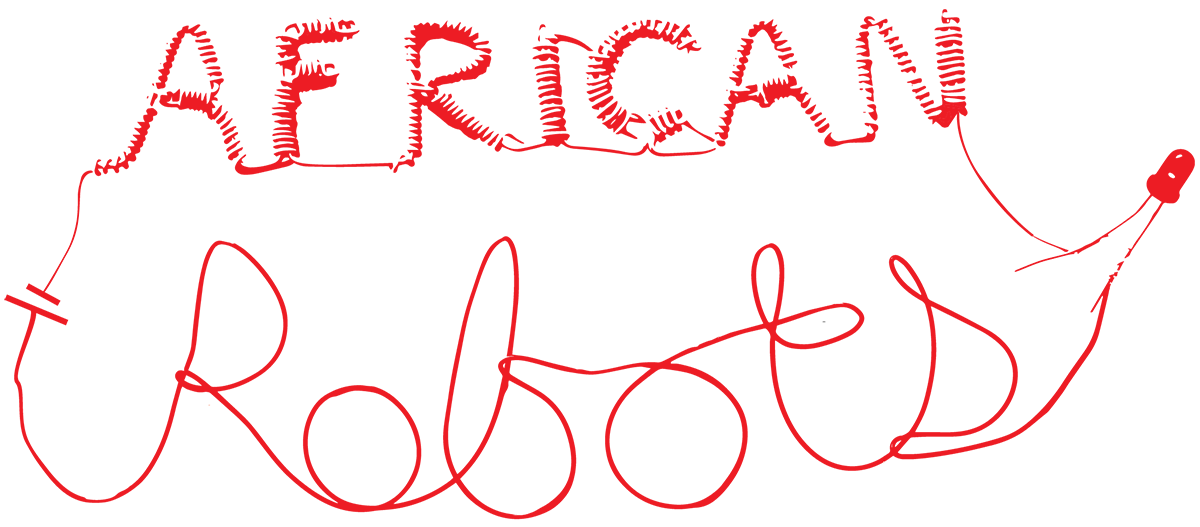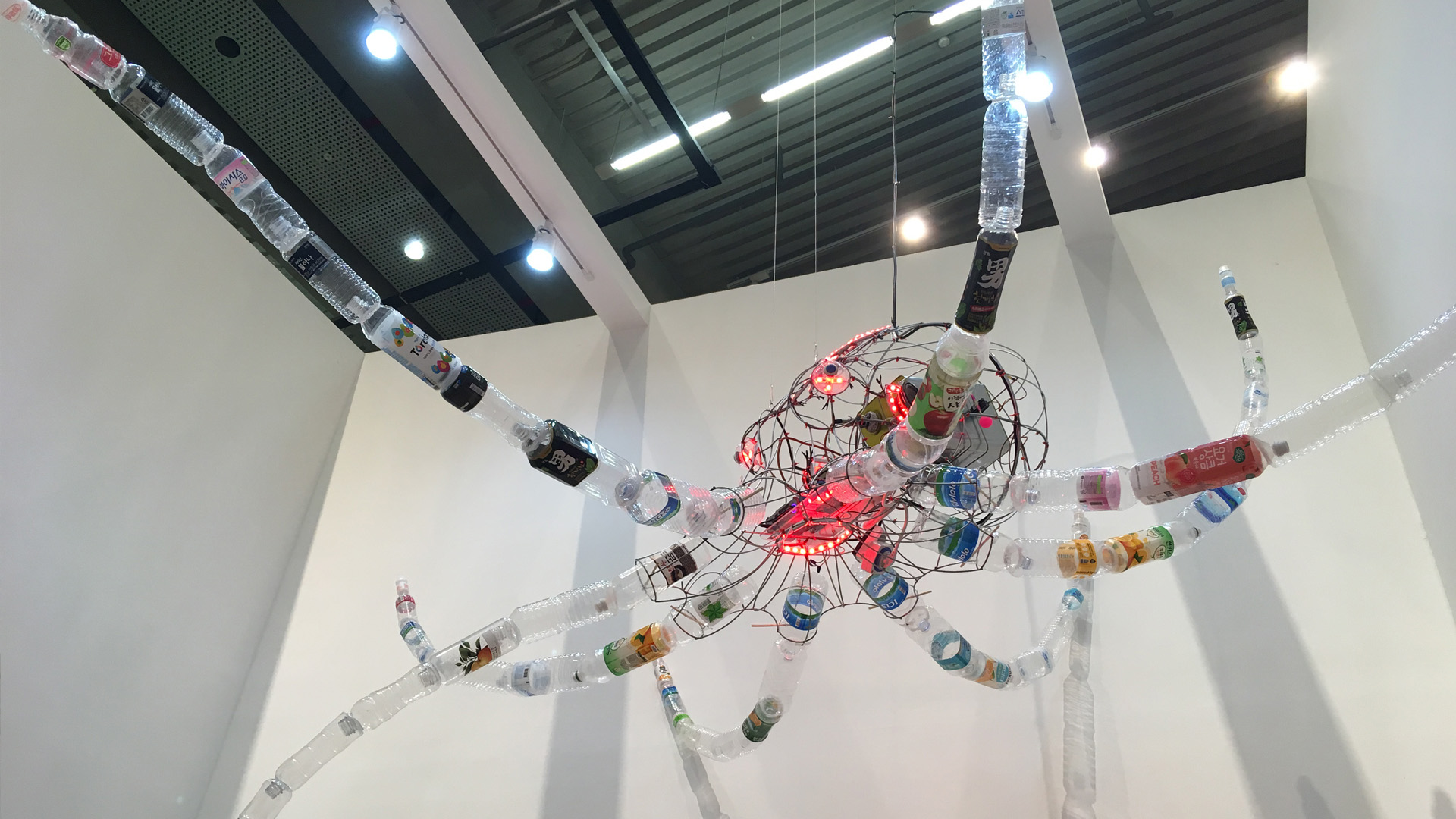Anthropophagic Octopus
식인낙지
From 22 May – 30 June 2019, African Robots lead artist Ralph Borland was on an art residency at the Asia Culture Centre in Gwangju, South Korea, with support from Business and Arts South Africa, making work for exhibition at the International Symposium of Electronic Arts 2019.
Ralph writes below about the project below:
“My proposal for work at ISEA2019 – Lux Aeterna was to apply the approaches I’ve taken with African Robots in South Africa, Zimbabwe, Mozambique and Brazil, to Gwangju: searching out local artists to collaborate with, and making a mechanical and electronic automaton based on a local creature, using a wireframe aesthetic and a mix of found and bought materials.
The challenge was to apply this project to a quite different socioeconomic and cultural context, and I wasn’t sure what I would find. South Korea is a first world economy, and so informal street artists and craftspeople like the wire artists I usually work with, were not to be found. An important lead I received from another residency artist was to the contemporary tradition of Buddhist lantern-making, which uses a wire-frame approach and incorporates lights and movement, and I did eventually work with a brilliant wire-frame sculptor, Li Ki Sung, who also makes Buddhist lanterns.
I found Ki Sung by a combination of chance and method – the method being the derivé or Situationist city ramble aka persistently wandering the streets and seeing what would turn up! While looking for collaborators I collected waste materials, from plastic bottles in a wide range of sizes and shapes, to thrown away technology and other bits and pieces which, combined with cheap technology bought on Gwangju’s Electron Street, become part of the final sculpture.
The subject for the automaton presented itself in my wanderings: I started out looking at squid as a ubiquitous creature for sale for food in the markets, but settled on the nakji, a small octopus eaten in abundance in Korea, and to be seen in tanks outside restaurants in the street. I chose the octopus because of its intelligence, and how that would fit with the metaphor I wanted to play on: instead of being eaten, the octopus would be an eater of culture, a representation of ‘anthropophagy’, or cultural cannibalism, which describes how countries on the global periphery demonstrate agency, rather than passivity, in their consumption and incorporation of culture from the centres of power.
(‘Southern agency’ was the subject of one of my post-docs and the paper I co-authored for Global Environmental Politics on MIT Press)
The application of the term ‘anthropophagy’ to this phenomenon was proposed by the Brazilian avant-garde writer Oswald D’Andrade in the 1920s, and realized in the Tropicalismo art movement in the 1960s and 70s. It’s an idea that resonates with my own experience of growing up in formerly colonised parts of the world, and of seeing how locations like ours consume and creatively rework music and arts from Europe and the US.
South Africa consumes Chicago house, pitches it down, marries with local musical cultures and produces kwaito. Right now South Africa gqom music is taking the electronic music world by storm – a local reinterpretation of dance music which uses the most basic computer programme Fruity Loops in unimagined new ways. And of course Korea has K-pop, Western pop eaten, reordered, and redistributed to the world. This is just in terms of pop culture – there are many other levels of culture on which this takes place.
The final work produced for exhibition at ISEA2019 was Anthropophagic Octopus, a large-scale wireframe octopus sculpture suspended overhead, with found plastic bottles for tentacles, and containing a mechanical and electronic percussion system. Strikers made from a chopstick, a steel ruler and a rubber ball hit different parts of a found tin can; the sound is picked up by a Karaoke microphone, echo and delay applied by a guitar delay pedal, and amplified through a Karaoke car amp and speakers. The repetitive percussive loop echoes the traditional Korean music form of sanjo or ‘scattered melodies‘, while the Karaoke audio technology, bought in local shops, evokes contemporary Korean popular culture.
The project builds on my recent collaborative sculpture produced by African Robots and SPACECRAFT Dubship I – Black Starliner which uses mechanical percussion, sound FX and amplification on a larger scale. Anthropophagic Octopus uses the echo and delay typical of dub music as a continuation of the theme of anthropophagy: the echo, in which sound is transmitted, modified and returned, has been interpreted in dub music as a metaphor for cultural transfer, with influences on reggae, dub, dancehall and hiphop echoing between Africa, the US and the Caribbean, and to the rest of the world.
This interactive artwork combines local and global references, waste and found materials, art and technology. It draws connections between digital 3D wireframe and hand-made sculpture, and blurs the boundaries between high and low art, culture and technology. The object produced is a vehicle for cultural exchange and connection”.
Exhibition text
African Robots in the City of Light – Anthropophagic Octopus
An African Robots project
By Ralph Borland with Lee Ki Sung
Metal, electronics, found materials
300 x 300 x 100 cm
African Robots is a project to introduce interactive electronics to street wire art practices in Southern Africa. Wire art, in which a simple hardware material, galvanised steel wire, is transformed through hand skill into complex three-dimensional forms, is a vernacular form of expression and a means of income in many parts of Africa. African Robots has travelled further abroad to engage with artists in other countries, such as Brazil in 2018, and now in Gwangju, South Korea. The work produced here with local artist Lee Ki Sung, who works with steel rod in a ‘wire frame’ style, is an ‘Anthropophagic Octopus’ based on the small nakji octopus, a popular local dish. This octopus eats rather than being eaten. ‘Anthropophagy’ is a concept framed in Brazil in the 1920s, which refers to ‘cultural cannibalism’ – the way in which non-western countries consume outside influences and make them part of their own body of culture. This interactive artwork combines local and global references, waste and found materials, art and technology. It draws connections between digital 3D wireframe and hand-made sculpture, and blurs the boundaries between high and low art, culture and technology. The object produced is a vehicle for cultural exchange and connection.

